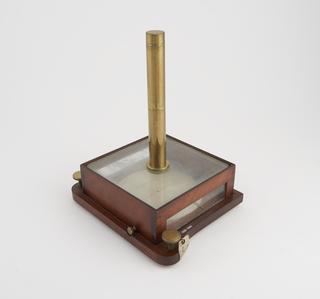
Dip circle by Robinson, c 1830.
- maker:
- Thomas Charles Robinson

Dip circle by Thomas Charles Robinson, c. 1830
Dip circles are used to measure the angle between the direction of the earth's magnetic field and the horizontal at any point on the earth's surface. A magnetic needle on a horizontal axis lies horizontally only at the magnetic equator, where the attraction to the poles is equally balanced. Elsewhere, the needle will dip to an angle which depends on the distance from the nearest magnetic pole. At the north and south magnetic poles the needle dips vertically. Dip circles were frequently taken on scientific expeditions from the 18th century onwards.
Details
- Category:
- Terrestrial Magnetism
- Object Number:
- 1980-1881
- type:
- dip circles
- credit:
- Meteorological Office




